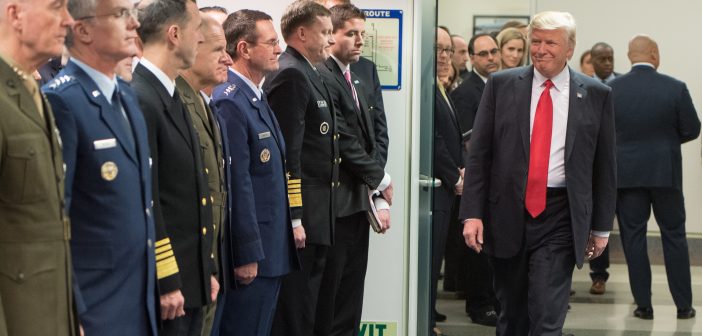Donald Trump’s election as America’s 45th president has fueled optimism on both Wall Street and in the defense industry of brighter times ahead.
During the campaign, Trump labeled the US military as broken, pledged to scrap the Budget Control Act and boost Pentagon funding.
And with Republicans in control of the White House and Congress promising to scrap the BCA, there was optimism about a Reagan-esque modernization buildup.
Trump promised to grow the Army from 450,000 to up to 540,000 soldiers, build a 350-ship Navy, increase the Air Force’s fighter fleet to 1,200 aircraft, and expand the Marines from 178,000 to 194,000. He also backed a comprehensive modernization of the nation’s nuclear forces.
Last week, he said he would increase defense spending by $54 billion or 10 percent, touting it as one of the largest increases in history. That figure would come on top of whatever is “saved” through a new drive to become more efficient that was launched soon after Jim Mattis became defense secretary.
But too many questions remain about the nature of the increase, it’s ultimate size and longevity. It’s worth remembering that the Reagan buildup was only a handful of years before deficit reduction measures were instituted that triggered spending cuts. It’s worth noting that the defense increases rely on equal cuts to the non-defense side of the budget.
It’s not encouraging that top military leaders are equally unclear regarding how much more money they are likely to get. Rather than being given budget targets to plan against, the administration has asked the services to submit needs for approval. During an interview last week, Gen. David Goldfein, the US Air Force chief of staff, admitted that he is unclear about his budget future and reiterated — as he has throughout his tenure — that budgetary uncertainty is his service’s biggest enemy.
For starters, it’s unclear whether $54 billion is an increase to the base budget or includes funds that would “migrate” from the Overseas Contingency Operations account that covers wartime expenses. With the advent of the BCA, the OCO has become the loophole with which to fund DoD base budget needs as well.
Sen. John McCain, R-Ariz., the chairman of the Senate Armed Services Committee, is among those disappointed with Trump’s spending increase that the Vietnam War hero deems too small of an increase to revitalize a DoD that has been enervated by years of anemic funding.
But the man who is now Trump’s budget chief, former Rep. Mick Mulvaney, R-S.C., is a fiscal hawk who on principle opposes abuse of the OCO and additional defense spending. Elected in 2010, Mulvaney was a Freedom Caucus leader who rejected deficit spending and was among the Tea Party members who were comfortable with a US debt default in 2011. It was to avert that debt default that the BCA was adopted, preserving America’s stellar credit rating, but imposing strict caps on defense and non-defense spending.
And with the BCA still law, the administration with have to negotiate with Democrats for a defense base budget increase. Pentagon spending may well increase, says Todd Harrison of the Center for Strategic and International Studies, but not by as much as being proposed and will be limited by whatever deal is negotiated with Senate Democrats.
At this point it’s worth noting that the national debt is at $20 trillion and rising. New tax cuts, the border wall, infrastructure spending and entitlement changes are likely to drive increased borrowing, the costs of which are steadily increasing
So the Trump proposal to spend more than the BCA will allow is not much different than the Obama administration that annually sought more money for DoD than it was going to get. What’s different this time is that there is a president who will accept a dramatic OCO increase. Then the question is whether the administration and defense spending enthusiasts in Congress can muster the political support for a $54 billion OCO hike and whether DoD could even spend so much money in one year, much less do so wisely. And OCO continues the year-to-uncertainty that makes defense spending inefficient.
The prospect that defense spending may not be as rosy as anticipated explains why some service chiefs have been so restrained in discussing their priorities. All want to improve readiness, the Air Force, Army and Marines want more personnel, and each are targeted in their acquisition needs.
The Army says it has shrunk too far, arguing it needs 90,000 more soldiers as the Air Force makes the case for 30,000 more airmen to execute its existing missions. The Marines recently said that they would like to grow the force to 194,000, but are considering plans that would increase the Corps to as many as 210,000.
Indeed, some fear the services – in their drive to enlarge – will spend whatever extra money they get on people that are increasingly expensive to recruit in an improving economy, only to be forced to cut them in a few years when the spending bulge ends.
While Goldfein makes the case for more airmen and better readiness, he’s far more restrained about his modernization priorities, stressing his top need is better network that will make his force of new and older planes more effective.
It’s a good, strategic call.
There is no doubt the Pentagon will get some more money over the coming years. But the spending increases may be more modest that rhetoric suggests. Prudence demands that the new administration prioritize defense needs and be realistic about what it’s likely to save through efficiency moves.
It’s a noble goal to cut cost and maximize bang for the buck. That a president would make efficiency a priority would set an admirable goal for his entire leadership team. To demand that outdated regulations be scrapped when new ones are adopted makes sense.
Trump and others have cited a 2014 Defense Business Board study that suggested DoD could save $125 billion in five years with more business-like practices, renegotiating contracts and getting rid of people through attrition. Maybe. There is no doubt that the Pentagon can become more efficient. It’s unclear whether this plan is the right approach nor will yield the promised savings. The trouble is that some past “efficiency” moves have ended up costing the Pentagon far more. In this endeavor, details and strategic vision matter.
Congress’ decision to force DoD to cut acquisition workers after the Cold War drove talent shortage that in turn led to bad procurement policies that sent weapons costs soaring, costs that were only brought under control over the past few years.
Mattis and his leadership team will have to continue making tough choices to improve US warfighting capabilities. They must resist the urge to increase troops any more than necessary or greenlight acquisition programs that do not directly contribute to the kinds of capabilities the nation needs to face future challenges.
They will also have to be careful make any moves in the name of efficiency that yield short term savings but incur long-term costs.




